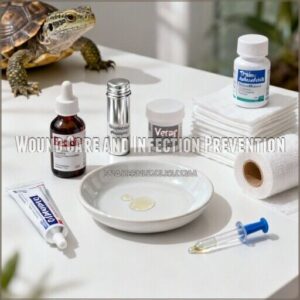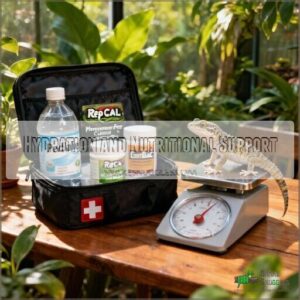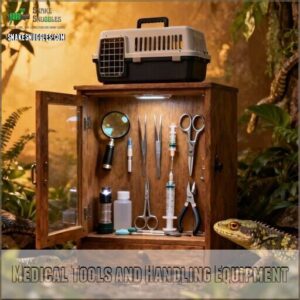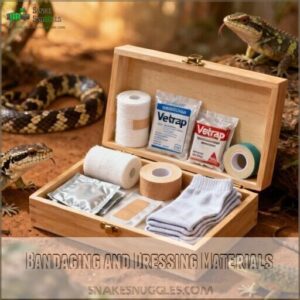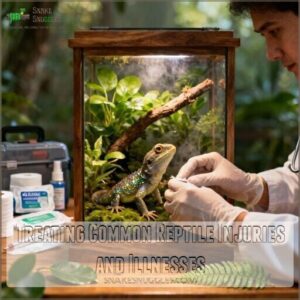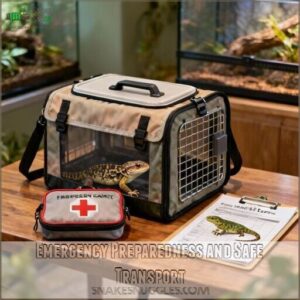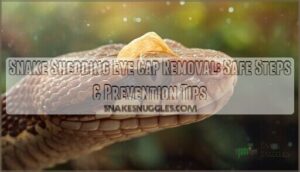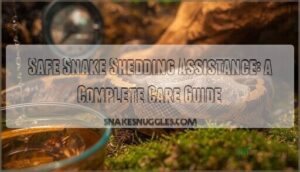This site is supported by our readers. We may earn a commission, at no cost to you, if you purchase through links.
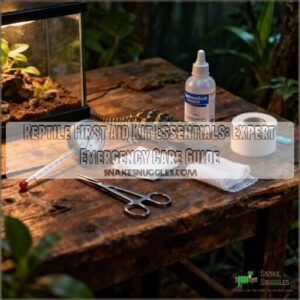
Burns, respiratory distress, and traumatic wounds account for nearly half of all reptile emergency cases, yet most owners don’t keep basic supplies within reach. A well-stocked reptile first aid kit essentials collection won’t replace veterinary care, but it buys you precious time and can prevent small injuries from spiraling into surgical emergencies.
Table Of Contents
Key Takeaways
- Burns, respiratory distress, and traumatic wounds make up nearly half of all reptile emergency cases, yet most owners lack basic supplies that can prevent minor injuries from becoming surgical emergencies.
- A well-stocked first aid kit should include chlorhexidine solution for disinfection, silver sulfadiazine ointment for burns, Pedialyte for dehydration, sterile gauze, Vetrap bandaging, and species-specific supplies like shell repair materials for turtles.
- Critical symptoms requiring immediate veterinary care include respiratory distress with bubbling nostrils or open-mouth breathing, uncontrolled bleeding beyond five minutes, neurological signs like seizures or stargazing, and sudden refusal to eat with bloody stool.
- Check your kit’s expiration dates every six months, never use human medications without vet consultation, and practice using medical tools on non-living materials like fruit before attempting procedures on your pet.
Why Every Reptile Owner Needs a First Aid Kit
Reptiles can face sudden health crises at home, and having the right supplies on hand can make the difference between a full recovery and a tragic outcome. When minutes matter, you won’t have time to rush to the store or wait for online orders.
Let’s look at the most common emergencies you might encounter, what happens when treatment is delayed, and why preparedness is essential for responsible exotic pet care.
Common Reptile Emergencies at Home
Reptile emergencies can happen in the blink of an eye, even in what seems like a well-maintained setup. Burns from heat lamps, respiratory infections from poor humidity, and metabolic bone disease from improper lighting are just a few scenarios that can quickly turn serious without prompt attention.
Quick wound care and proper restraint can make the difference between a minor issue and a life-threatening crisis. Reptiles can also experience trauma leading to fractures requiring stabilization.
- Burns and temperature shock from exposed heat sources account for up to 25% of emergency cases
- Shell fractures in turtles and tortoises from falls or household accidents requiring surgical repair
- Respiratory infections like pneumonia making up roughly 22–29% of urgent vet visits
- Dehydration needing immediate fluid therapy in about 17% of first aid situations
- Animal bites from household pets causing traumatic wounds, especially in smaller reptiles
Risks of Delaying First Aid for Reptiles
When you wait too long to treat a reptile injury, you’re not just risking infection—you’re watching their already slow metabolism work against them. Delayed healing means tissue damage spreads faster than their immune system can cope with it.
Delaying reptile first aid lets tissue damage outpace their slow immune response, turning treatable injuries into emergencies
Reptile emergencies like untreated burns or cuts quickly escalate into complications that need emergency veterinary care. Pain amplification occurs as wounds worsen, making restraint and treatment harder. What starts as manageable becomes a crisis requiring surgical intervention.
Benefits of Being Prepared for Exotic Pets
Having your reptile first aid kit stocked and ready turns panic into action when something goes wrong at 2 a.m. on a Sunday. Emergency preparedness means you’re giving your pet the best shot at a faster recovery while building owner confidence through hands-on care. Here’s what being prepared delivers:
- Reduced vet visits for minor reptile emergencies you can address at home
- Stronger bonds formed through attentive, proactive care
- Cost savings by treating small issues before they escalate
- Faster recovery when first aid supplies are within reach
- Owner confidence knowing you won’t freeze during a crisis
Essential Supplies for a Reptile First Aid Kit
A well-stocked first aid kit can mean the difference between quick recovery and a trip to the emergency vet. Your kit should include supplies for treating wounds, supporting nutrition, and managing your reptile safely during care.
Let’s break down what you’ll need to have on hand for common emergencies.
Wound Care and Infection Prevention
Think of your reptile wound treatment supplies as your frontline defense against infection. You’ll need chlorhexidine solution for wound disinfection—it fights bacteria, viruses, and fungi without leaving toxic residue. Keep Betadine for topical antisepsis on open injuries. Silver sulfadiazine ointment provides antimicrobial protection for burns and abrasions. Stock styptic powder to stop minor bleeding instantly, especially during nail trims.
Include sterile gauze, triple antibiotic ointment without painkillers, and proper bandaging techniques using Vetrap. You can also use Pedialyte replenishes hydration in reptiles that are dehydrated.
Preventing infection starts with wound assessment and prompt antiseptic application in your reptile first aid kit.
Hydration and Nutritional Support
When your reptile refuses food or can’t absorb nutrients properly, you’ll need emergency feeding supplies on hand. Stock unflavored Pedialyte as an electrolyte drink for dehydrated reptiles—it aids hydration and electrolyte replacement fast. Rep-Cal Phosphorous-Free Calcium Powder provides urgent calcium supplementation for species prone to metabolic bone disease.
Keep Emeraid Intensive Care Nutrition for emergency feeding situations. Add NutriBAC for probiotic use after antibiotic treatments. A kitchen scale facilitates weight monitoring to catch health declines early.
Medical Tools and Handling Equipment
A magnifying glass and penlight are observation tools that help you spot parasites, wounds, or small skin changes requiring attention. Tweezers, hemostats, and surgical scissors enable careful manipulation and wound cleaning through proper tool sterilization.
Insulin syringes provide precise dosage for medications. Nail clippers prevent overgrown claws.
Keep a pet carrier ready for emergency transport.
Bandaging and Dressing Materials
Sterile gauze squares and rolls absorb fluids and cover wounds, shielding them from bacteria. Vetrap secures gauze with flexible, firm bandaging around limbs or tails.
Paper and adhesive tape attach dressings while minimizing skin irritation. Non-spermicidal condoms protect snake tails gently.
Clean tube socks immobilize injured limbs during transport, preventing further damage.
Treating Common Reptile Injuries and Illnesses
When your reptile gets hurt or sick, knowing what to do can make all the difference. The supplies in your first aid kit are only useful if you know how to use them properly.
Let’s walk through the most common situations you’ll face and how to approach them with confidence.
Cleaning and Dressing Wounds
When a wound happens, every second counts—but panic won’t help your reptile heal faster. Start by gently restraining your pet and examining the injury.
Use Betadine or chlorhexidine solution to clean the area, removing debris with gauze. Apply silver sulfadiazine to prevent infection, then dress with non-stick gauze secured by Vetrap.
Watch for infection signs like swelling or discharge. Replace dressings daily unless your vet advises otherwise.
Managing Burns, Cuts, and Broken Shells
Burns and broken shells demand urgent attention—delay can mean the difference between recovery and infection. For burn severity, rinse with cool water and apply silver sulfadiazine immediately to prevent bacteria from spreading. Deep cuts exposing bone need immediate vet care to avoid cut infections.
Shell repair requires:
- Clean the area with Betadine solution to stop infection
- Apply silver ointment as a protective barrier against bacteria
- Cover with non-stick gauze secured by Vetrap for proper healing
Monitor for scale damage and signs of worsening. Proper reptile wound treatment now prevents serious complications later.
Handling Dehydration and Heatstroke
Dehydration sneaks up fast in reptiles—they can’t pant, sweat, or tell you they’re thirsty, so you need to spot the warning signs before it’s too late. Recognizing dehydration means checking for sunken eyes, wrinkled skin, and lethargy. For treating dehydration in reptiles, offer unflavored Pedialyte to restore electrolyte balance. Heatstroke requires immediate cooling techniques—move your pet to shade and mist with cool water, never ice-cold.
| Symptom | Action |
|---|---|
| Sunken eyes, wrinkled skin | Administer Pedialyte orally |
| Overheating, gasping | Apply cool water mist |
| Lethargy, weakness | Lower temperature gradually |
| Refusing food/water | Seek veterinary care |
Your reptile first aid kit and quick hydration methods prevent reptile emergency care situations from escalating. Preventing heatstroke starts with proper habitat temperatures.
Supporting Shedding and Skin Health
Shedding problems don’t just make your reptile look rough—they signal deeper health issues that can lead to infections, constricted blood flow, and serious discomfort if you ignore them. Understanding what causes snake stuck shed—from low humidity to poor nutrition—helps you address the root problem instead of just treating symptoms.
Keep A+D ointment handy for stubborn shed and scale rot—it creates a protective barrier while promoting wound healing.
Maintain proper humidity control to prevent mite infestations and reptile shedding problems before they start.
Emergency Preparedness and Safe Transport
When a reptile emergency strikes, having the right supplies won’t matter if you can’t safely get your pet to the vet. A well-prepared emergency carrier and organized health records can make the difference between a smooth transport and added stress for both you and your reptile.
Here’s what you need to have ready before an emergency happens.
Assembling a Reptile Emergency Carrier
Before panic sets in during a reptile emergency, having a proper carrier ready can mean the difference between a smooth vet visit and a stressful scramble. Choose a pet carrier with secure features that guarantee proper ventilation. Line it with a textured towel for grip and stress reduction.
For cold-weather transport, include a heat pack like UniHeat shipping warmers to maintain temperature control. Clean your carrier after each use to prevent contamination.
Important Contact Information to Keep Handy
A carrier is only helpful if you can reach the right people once you’re on your way, so keep a list of emergency contacts stored where you won’t have to hunt for it. Include your primary veterinarian and at least two emergency vet clinics that treat reptiles.
Add phone numbers for your Local Herp Society, Exotic Vet Finder resources, Poison Control, and nearby Reptile Rescues. Store your pet insurance details alongside these Emergency Contacts for quick access during emergency veterinary care situations.
Record Keeping and Monitoring Health Changes
Once you’ve got those numbers on hand, keeping a simple log of your reptile’s weight, eating habits, and behavior patterns can help you spot trouble before it becomes a crisis. Weight tracking and feeding logs reveal health conditions early, while monitoring shedding cycles and temperature records helps you identify patterns.
Keep medication records and animal health records organized so your vet has the full picture when seconds count.
When to Seek Veterinary Care
Knowing when your reptile needs professional help can make the difference between a quick recovery and a serious complication. While your first aid kit addresses many minor issues, some symptoms demand immediate veterinary attention.
Let’s walk through the warning signs you shouldn’t ignore, how to stabilize your pet before transport, and practical ways to manage the costs of emergency care.
Recognizing Critical Symptoms
Knowing when reptile health emergencies demand veterinary care can mean the difference between life and death. Watch for these critical health issues:
- Respiratory distress – bubbling nostrils, wheezing, or open-mouth breathing signal serious trouble
- Neurological signs – stargazing, seizures, or loss of coordination indicate urgent problems
- Trauma indicators – uncontrolled bleeding beyond five minutes or visible bone requires immediate attention
- GI distress – persistent vomiting, bloody stool, or sudden refusal to eat
- Systemic illness – lethargy, skin blisters, or rapid weight loss point to infection
Don’t wait when you spot these emergency situations—recognizing reptile symptoms early improves outcomes dramatically.
Temporary At-Home Care Before The Vet
When you’ve spotted critical symptoms but can’t reach a vet immediately, you’ll need to stabilize your reptile at home until professional help becomes available. Keep your animal warm, quiet, and isolated from other pets. Monitor breathing patterns and check wounds every hour. Your reptile first aid kit should contain emergency care supplies for managing reptile injuries temporarily.
Make dietary adjustments by withholding food until examination. Proper wound care and first aid supplies bridge the gap before professional treatment.
| Emergency Situation | Comfort Measures | Safe Procedures |
|---|---|---|
| Bleeding wounds | Apply styptic powder; secure gauze with Vetrap | Minimize movement; support body fully |
| Respiratory distress | Increase humidity; assure airflow | Treat gently; avoid chest pressure |
| Dehydration | Offer Pedialyte via syringe | Reduce stress during symptom observation |
| Burns/trauma | Cool compress; silver sulfadiazine ointment | Wear gloves; maintain isolation protocols |
Managing Vet Bills and Insurance Options
Exotic veterinary care doesn’t come cheap, but you can soften the financial blow with smart planning and the right coverage options. Pet insurance for exotics helps manage vet bills before emergencies strike.
Look into payment plans or a CareCredit card for spreading veterinary costs over time. Building emergency funds specifically for your reptile ensures you’re ready when preventative care turns urgent.
Frequently Asked Questions (FAQs)
How often should I update first aid supplies?
Check expiration dates every six months on medical supplies like Betadine and silver sulfadiazine. Replace items after use, and adjust for seasonal needs—heatstroke supplies in summer, humidity aids in winter. Storage conditions matter too.
Can I use human medications on reptiles?
Never give human medications to your reptile without vet consultation. Toxicity concerns and dosage considerations differ drastically between species.
Safe alternatives exist specifically formulated for reptiles, reducing medication risks and ensuring proper veterinary care.
What temperature should supplies be stored at?
Store your reptile first aid kit in a cool, dry spot between 60-75°F. Temperature control matters because heat degrades medications, while humidity levels can ruin gauze and bandages. Proper storage conditions protect your emergency kit’s effectiveness.
How do I practice using medical tools safely?
Practice with non-living materials first—use fruit for scalpel grips and surgical procedures, or apply tweezers and styptic powder on models.
Master sterilization methods and manipulation techniques with disposable gloves before attempting emergency protocols on your pet.
Should different species have separate first aid kits?
You can use one all-encompassing reptile first aid kit for multiple species. However, species-specific kits improve emergency reptile care by organizing supplies for each reptile’s unique needs, like shell repair materials for turtles or shedding aids for snakes.
Conclusion
The difference between a scar and a tragedy often comes down to those first five minutes—and whether you’d the right supplies within arm’s reach.
Your reptile first aid kit essentials won’t replace a vet, but they bridge the gap when seconds matter. Keep it stocked, know where it lives, and review the contents every few months.
When your snake’s next escape ends badly or your gecko’s lamp fails, you’ll be the reason their story has a better ending.

